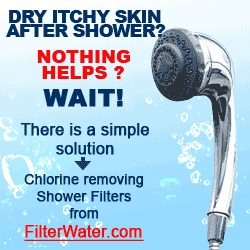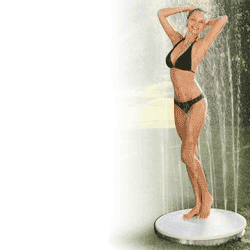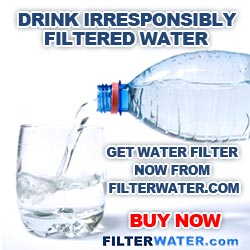|
ANSI/NSF Standards for Drinking Water Treatment Units
Your Drinking Water Standards...
These standards represent only some of the many standards established by NSF for domestic drinking water systems. Standard 42: Aesthetic Effects This standard primarily deals with Chlorine removal, appearance and Taste and Odor claims. Chlorine A chlorine reduction claim means the system reduces the concentration of chlorine in the water. This category is broken down into classes that represent a certain level of Chlorine removal. Class I - 75% or greater Chlorine reduction Class II - 50% - 74% Chlorine reduction Class III - 25% - 49% Chlorine reduction Particulates A performance claim for Particulate removal means the system removes particles of a certain size based on the following classes: Class I - Reduces 85% of particles 0.5 to < 1 microns in size Class II - Reduces 85% of particles 1 to < 5 microns in size Class III - Reduces 85% of particles 5 to < 15 microns in size Class IV - Reduces 85% of particles 15 to < 30 microns in size Class V - Reduces 85% of particles 30 to < 50 microns in size Class VI - Reduces 85% of particles equal to or greater than 50 microns in size 
Standard 53: Health Effects This standard is concerned with contaminants that may pose a health risk such as: Your Drinking Water Standards...
Lead Volatile Organic Compounds (V.O.C.'s) Inorganic Chemicals Cysts Radon Turbidity Pesticides and Herbicides Trihalomethanes (THM's) Volatile Organic Chemicals (V.O.C.'s) A performance claim for V.O.C. reduction means the system reduces the concentration of all of the following contaminants. Some of these chemicals can be tested individually for performance claims.
Alachlor 1,2-Dichloropropane Styrene Atrazine cis-1,3-Dichloropropylene 1,1,2,2-Tetrachloroethane Benzene Dinoseb Tetrachloroethylene Carbofuran Endrin Toluene Carbon Tetrachloride Ethylbenzene 1,2,4-Trichlorobenzene Chlorobenzene Ethylene Dibromide (EDB) 1,1,1-Trichloroethane Dibromochloropropane (DBCP) Heptachlor 1,1,2-Trichloroethane o-Dichlorobenzene Heptachlor Epoxide Trichloroethylene p-Dichlorobenzene Hexachlorobutadiene Trihalomethanes (THMs) 1,1-Dichloroethane Hexachlorocyclopentadiene m-Xylene 1,2-Dichloroethane Lindane o-Xylene
trans-1,2-Dichloroethylene Methoxychlor p-Xylene 1,1-Dichloroethylene Pentachlorophenol 2,4-D cis-1,2-Dichloroethylene Simazine 2,4,5-TP(silvex) Cysts A performance claim for cysts indicates the system reduces the concentration of parasitic cysts by at least 99.95%. The cysts included in this claim are Cryptosporidium, Giardia, Toxoplasma and Entamoeba. Turbidity A claim for turbidity reduction means the system removes fine particulate matter that makes water appear cloudy to a level below the U.S. EPA Maximum Contaminant Level. Lead A performance claim for lead reduction demonstrates the system's ability to reduce the concentration of lead below the U.S. EPA Maximum Contaminant Level. California Department of Health Services Certification Program for Drinking Water Systems The California Department of Health Services certifies all residential water treatment devices sold in the state that make health claims. Water filter systems that claim to reduce, filter or treat any chemical or compound that the state or federal government has determined presents a health concern in drinking water must be certified to be sold in California. Examples of health benefit claims include a device's ability to reduce or filter lead and other heavy metals, bacteria, cysts, nitrates, organic chemicals and pesticides. Most testing for certification is done according to protocols that are part of the NSF International Standards. The testing establishes that the water treatment device provides sufficient reduction of contaminants to warrant certification. Testing also determines that the materials used to construct the system will not contribute harmful contaminants to the treated water. The manufacturer must comply with product labeling and consumer information requirements before a device can be certified. A product data sheet is provided for each product and includes: Rated Service Life General Use Conditions Model or Part Numbers for Replacement Elements Maximum and Minimum Operating Temperatures Maximum and Minimum operating Pressure Cost of Replacement Elements Types of Contaminants Tested and Listed on Certificates VOCs (Volatile Organic Compounds) 1Alachlor Atrazine Benzene Bromodichloromethane 2 Bromoform2 CarbofuranCarbon Tetrachloride Chlorobenzene Chloroform 22,4-D DBCP Chlorodibromomethane 2o-Dichlorobenzene p-Dichlorobenzene 1,1,-Dichloroethane 1,2-Dichloroethane trans-1,2-Dichloroethylene 1,1-Dichloroethylene cis-1,2-Dichloroethylene 1,2-Dichloropropane cis-1,3-Dichloropropylene Dinoseb EDB (ethylene dibromide) Endrin Ethylbenzene Heptachlor Heptachlor Epoxide Hexachlorocyclopentadiene Hexachlorobutadiene Lindane Methoxychlor Pentachlorophenol Simazine Styrene 2,4,5-TP (Silvex) Tetrachloroethylene 1,1,2,2-Tetrachloroethane Toluene 1,2,4-Trichlorobenzene 1,1,1-Trichloroethane 1,1,2-Trichloroethane Trichloroethylene m-Xylene o-Xylene p-Xylene 1. Based on testing with chloroform surrogate per Section of NSF Standard 53 (revised March 1994). 2. Organic chemicals referred to as Trihalomethanes, Total Trihalomethanes, TTHMs and THMs. Other Organics 3Chlordane Trihalomethanes (THMs): 1,2,3-Trichlorobenzene Bromodichloromethane PCBs Bromoform m-Dichlorobenzene Chloroform Toxaphene Dibromodichloromethane MTBE 3. Some manufacturers chose to test for a few specific organic contaminants and for THMs. Microbiological Contaminants and Turbidity Bacteria Turbidity Cysts (protozoan) Virus Inorganic and Radiological Contaminants Arsenic Lead Asbestos Mercury Barium Nickel Cadmium Nitrate Hexavelent Chromium Nitrite Trivalent Chromium Radium 226/228 Copper Selenium Fluoride Silver 44. No longer a primary drinking water standard (MCL) but does appear on some certificates The contaminants that are listed above are considered toxins and are harmful to our body. Once ingested continuously into the body by drinking unfiltered water, the body cells and its organs will be affected and the immune system deteriorates eventually causing diseases. The removal of these toxins is possible thru ganotherapy or the red mushroom therapy. To learn about the ganotherapy and how it works, just click this link: The Ganotherapy page
|










